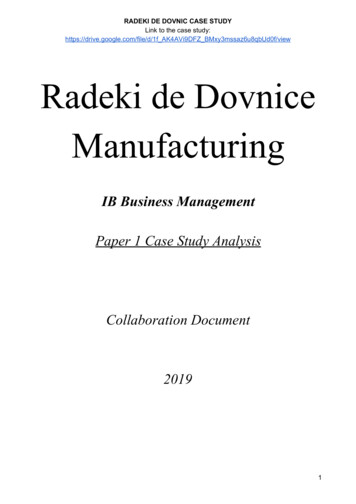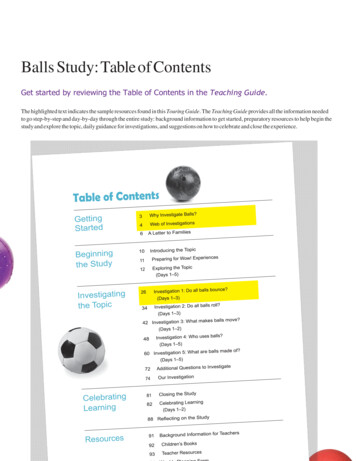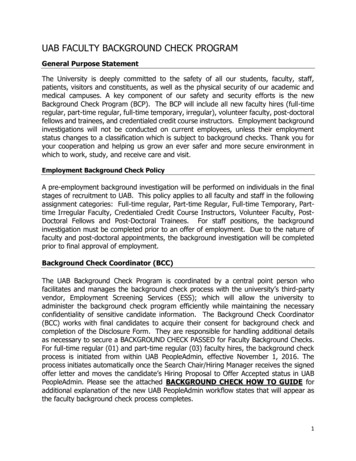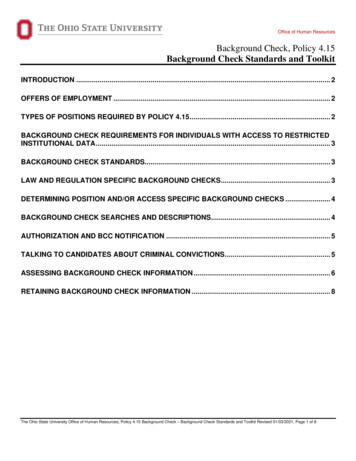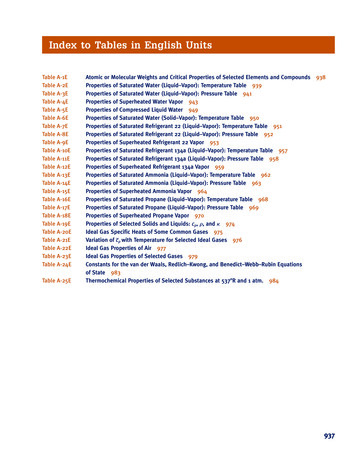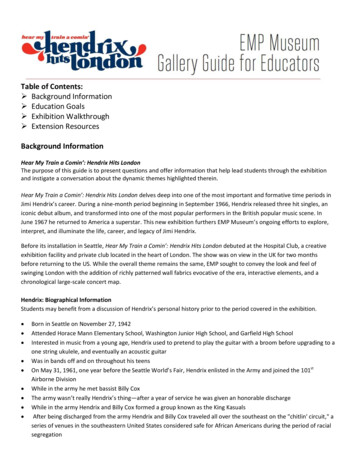
Transcription
Table of Contents: Background Information Education Goals Exhibition Walkthrough Extension ResourcesBackground InformationHear My Train a Comin’: Hendrix Hits LondonThe purpose of this guide is to present questions and offer information that help lead students through the exhibitionand instigate a conversation about the dynamic themes highlighted therein.Hear My Train a Comin’: Hendrix Hits London delves deep into one of the most important and formative time periods inJimi Hendrix’s career. During a nine-month period beginning in September 1966, Hendrix released three hit singles, aniconic debut album, and transformed into one of the most popular performers in the British popular music scene. InJune 1967 he returned to America a superstar. This new exhibition furthers EMP Museum’s ongoing efforts to explore,interpret, and illuminate the life, career, and legacy of Jimi Hendrix.Before its installation in Seattle, Hear My Train a Comin’: Hendrix Hits London debuted at the Hospital Club, a creativeexhibition facility and private club located in the heart of London. The show was on view in the UK for two monthsbefore returning to the US. While the overall theme remains the same, EMP sought to convey the look and feel ofswinging London with the addition of richly patterned wall fabrics evocative of the era, interactive elements, and achronological large-scale concert map.Hendrix: Biographical InformationStudents may benefit from a discussion of Hendrix’s personal history prior to the period covered in the exhibition. Born in Seattle on November 27, 1942Attended Horace Mann Elementary School, Washington Junior High School, and Garfield High SchoolInterested in music from a young age, Hendrix used to pretend to play the guitar with a broom before upgrading to aone string ukulele, and eventually an acoustic guitarWas in bands off and on throughout his teensOn May 31, 1961, one year before the Seattle World’s Fair, Hendrix enlisted in the Army and joined the 101stAirborne DivisionWhile in the army he met bassist Billy CoxThe army wasn’t really Hendrix’s thing—after a year of service he was given an honorable dischargeWhile in the army Hendrix and Billy Cox formed a group known as the King KasualsAfter being discharged from the army Hendrix and Billy Cox traveled all over the southeast on the "chitlin' circuit," aseries of venues in the southeastern United States considered safe for African Americans during the period of racialsegregation
During this time Hendrix played with Tina Turner, Sam Cooke, the Isley Brothers, Little Richard, and many othersBy 1966 Hendrix was playing in Greenwich Village and struggling to find an audience with his group Jimmy Jamesand the Blue Flames. During this period he met Chas Chandler (former bassist of the Animals) who promised hecould make Hendrix a star if he moved to EnglandHendrix agreed to follow Chandler’s advice on one condition: that Chandler introduce him to British guitar legendsJeff Beck and Eric ClaptonThe Music of HendrixInfluencesThe blues influence on Hendrix’s style is pronounced in much of his music. Growing up, Hendrix had a wide variety ofmusical idols. Blues artists such as Howlin’ Wolf, Muddy Waters, and Chuck Berry had an early influence on the guitarist.Primarily self-taught, Hendrix often learned to play songs by ear from listening to the radio or a record. His father ownedmany 45 records. Below are some of the records that Hendrix would likely have listened to:Etta James, “Don't Cry Baby” / “Sunday Kind of Love”James Brown with the Famous Flames, “Please, Please, Please” / “Why Do You Do Me”Frankie Ford, “You Talk Too Much” / “You've Got Troubles”Bobby Bland, “Saint James Infirmary” / ”Don't Cry No More”Jimmy Smith, “I Got a Woman” / ”Alfredo”Lloyd Price, “You Need Love” / “Stagger Lee”The Coasters, “Poison Ivy” / “I'm a Hog for You”The Imperials, “Tears on My Pillow” / “Two People in the World”The Wailers, “Velva” / “Mashi”Jimmy Forrest, “Remember“ / “Bolo Blues”Little Richard, “By the Light of the Silver Moon” / “Wondering”Ray Bryant Combo, “Sack o' Woe” / “Walk No More"The Crests, “16 Candles” / “Beside You”Hendrix and the BluesPrevious to his time in London, Hendrix spent about two years playing in the southern US playing back-up for variousmusicians. It was on the chitlin' circuit, immersed in soul, R&B, and blues, where Hendrix refined his distinctive style. Inthe early 1960s blues and R&B were mainly associated with “black music” in the US. Coincidentally, Hendrix left forLondon at a time when American blues was peaking in popularity in the UK. The blues Hendrix experienced andperformed on the chitlin’ circuit was being heavily utilized by different British musicians. American blues artists such asRobert Johnson, Sonny Boy Williamson, and Muddy Waters, among others were a huge influence on musicians such asEric Clapton and Keith Richards. This undoubtedly helped in Hendrix’s introduction to the London music scene.Hendrix and CompositionHendrix is known for his compositional flavor especially in his guitar solos. Important distinctions of Hendrix’s musicinclude his use of double stops/two note hammers, vibrato, effects, and plenty of feedback. He also utilized veryinventive chord choices for a rock guitarist, specifically, the use of dominant 7 sharp 9th chords, which have a veryheavy, sad, or tense sound. Hendrix’s use of this chord led it to become known as the ‘Hendrix chord.’ Examples of the‘Hendrix chord’ include the E7#9 used in “Purple Haze.”2
Education GoalsVisitors will gain a deeper understanding of the inspirations, personal history, career, and legacy of Jimi Hendrix. Learning Objective Areas:o Hendrix Hits London Explore creative moments in Hendrix’s career during the time period 1966–1967 Trace the evolution of how an anonymous everyman became one of the most unique and influentialcharacters in the history of popular music Discover how the city of London—its unique character, cosmopolitan nature, deep historical roots,and diverse music scene—influenced Hendrixo Changing Social Climates Examine the public reception to Hendrix and his music during a time of rapid societal change Investigate how popular trends, aka “the scene,” shifted in London from Dandy to Hippie and fromBritish blues and R&B to psychedelia Trace how these changes are reflected in both the US and abroad Suggested subject area connections:o History Research world events during the time period 1966–1967 What issues were the US and the UK facing? In what ways might the political climate have affected popular music themes at this time?o Social Studies Investigate watershed events in the civil rights movement taking place in the US and how theseevents resonated in the UK Investigate Hendrix’s career pre-London. How did perception of him in the US and the venues heplayed (for example his time on the “chitlin circuit”) differ from his experience in the UK?o Visual Arts Observe the shifting fashion in London during the late 60s. Describe the defining features of eachstyle such as mod, dandy, military revival, and emerging hippie fashion. Discuss various popular fashion trends. What factors contribute to certain styles gaining inpopularity while others die out? Design your own updated fashion style reminiscent of those popular in London during this time.o Language Arts and Writing Read examples of Hendrix’s lyrics. What adjectives would you use to describe his style? Review the connections between poetry and songwriting. What are some similarities anddifferences?o Mathematics Examine the formula behind the fret distribution of the electric guitar to ensure its intonation Observe the changes in frequency for a given note, its octave, perfect fifth, and major third. Howcan this be expressed by a mathematical ratio?3
How does a museum exhibition take shape?Similar to a theatre production or a feature film, museum exhibitions require a creative team of highly-skilled peopleworking together to complete the many facets of the project. Listed below is a selection of jobs integral to creating anew exhibition, and descriptions of their role in the creative process.oCurator: Oversees the overall creative direction, writes the narrative, selects and sources artifacts, andrepresents the exhibition to the press and public. The curator’s artistry is in choice, what they focus on totell a particular story through artifacts, film, media, and interactive experiences, and oral histories that leadthe audience into specific areas of exploration within the chosen themes of the exhibition.oExhibit Designer: Develops the physical exhibition components and gallery layout to best reflect thenarrative and tone of the exhibition. With the curator, the designer makes choices about the colors andmaterials to be used as well as the look and feel of the exhibition.oSound Designer: Creates audio and or musical accompaniment for the exhibition.oExhibitions Manager: Plans and oversees the design, fabrication, and installation of the exhibition.oFabricator: Artifacts come in all difference shapes and sizes. From flying V guitars to flying saucers,fabricators create custom mannequins used to display costumes, custom casework, and displays for EMP’sunique collection.oGraphic Designer: Responsible for creating the many visuals, logos, and text panels you see in the exhibitincluding choice and size of fonts, taking into account practical questions as to audience appeal and howappropriate the style is for a particular exhibition.oPreparator: Creates, mounts, and installs artifacts safely within the exhibition.oRegistrar: Tracks the artifacts in the exhibition, and ensures that they are properly stored and displayed toavoid damage.oVideo Producer: Films oral history interviews and creates interpretive films specific to the exhibition.oInteractive Producer: Develops digital and mechanical interactives in the exhibition to further engagevisitors.oMuseum Technician: Takes care of all technological needs, ensuring that interactive installations andaudio/video components are properly installed within the museum’s tech systems.4
oMarketing Manager: Handles all advertising and press-related issues regarding museum exhibitions.oMuseum Educator: Creates education resources and interpretive materials for school groups and thegeneral public.oPublic Programs Coordinator: Creates programs and events that showcase museum exhibitions for thepublic. Exhibition Design ProcessAlthough the creative design process for exhibitions may vary, development generally follows these steps:o Concept design and development – Goals and themes for the exhibition take shape, an artifact list is createdalong with layouts, schematics, and pre-visualization imagery to demonstrate the look and feel of theexhibition.o Interactive and sound development – Goals and objectives for each interactive installation are established,creation is outsourced as necessary.o Construction drawings – Final blueprints for the layout of the gallery are created.o Fabrication – Artifact casework is created.o Installation – Artifacts are installed in the gallery.Exhibition WalkthroughThe exhibition layout is arranged chronologically. Beginning the visit with the gallery closest to Sky Church andcontinuing clockwise will allow visitors to view Hendrix’s experiences in London in a linear fashion. Hendrix Hits LondonReflection Question: What images come to mind when you think of Hendrix?o The nine-month period beginning in September 1966 is regarded by many as the most important and formativetime in Hendrix’s career.o Hendrix’s transformation started on the plane to London where he decided to change his name from Jimmy toJimi.o In September 1966 when Hendrix arrived, London was enjoying a youth-driven cultural renaissance. Led by TheBeatles and The Rolling Stones, the city had become the epicenter of the country’s revitalized music scene.o Hendrix’s blues style was unique at the time in London. Many of the blues musicians popular in the UK werefrom the previous generation, whereas Hendrix was a contemporary musician.o During his first few weeks in London Hendrix jammed with notable British musicians such as The Animals’ EricBurdon and Eric Clapton of Cream. Chas Chandler quickly arranged auditions to form a band, subsequently hiringNoel Redding on bass and Mitch Mitchell on drums to create what would be known as The Jimi HendrixExperience.o The music industry of the 1960s centered on singles. Following this model, The Jimi Hendrix Experience releasedseveral singles before releasing their first album titled “Are You Experienced.”5
ooooThe first of these singles was “Hey Joe,” whose B-side featured the song “Stone Free,” Hendrix’s first originalvocal recording with The Jimi Hendrix Experience.“Hey Joe” rose steadily and remained in the Top 10 UK charts for several months. Of the release, Mick Jaggerwas quoted as saying, “That Jimi Hendrix record is just great! I wish I’d done this.” Disc and Music Echo, February4, 1967.Object Focus: Acetate recording of “Hey Joe” / “Stone Free,” November 1966.Acetates are fragile discs made of aluminum, coated in lacquer, and encoded with audio via a cutting lathe. JimiHendrix may have had this copy made after a recording session to listen to the songs at home.Object Focus: “Purple Haze” / “51st Anniversary” promo, Track, UK, 1967.Hendrix was a science fiction fan. “Purple Haze” was influenced by imagery from Philip José Farmer’s 1957novel, Night of Light. Hendrix and FashionReflection Question: How would you describe Hendrix’s choice of fashion and how would these same styles beperceived today?o Hendrix is famous for his eclectic taste in stage outfits.o One type of popular menswear fashion in London at this time was referred to asDandyism (or Peacock Style). This style is characterized by a refined or “bespoke”look, which means tailored to the individual.o Several outfits owned by Hendrix are featured in the first room of the exhibition.The casework for these outfits is meant to resemble a boutique clothing store.o As with many current fashion trends, not everyone agreed on what wasacceptable. In the 1960s, it became legal for UK civilians to purchase and wearmilitary garments, which became quite fashionable. Some felt that it wasdisrespectful. Hendrix responded to their criticisms by stating: “Some people havesaid that wearing a uniform is an insult to the army—but I wear these jackets outof respect. I hate war but I respect a fighting man. Would they rather his uniformfaded and withered away like the memory of the man that wore it?” Jimi Hendrix,Green velvet jacket, worn inRave, March 1967.1967o Object Focus: Green velvet jacket, worn in 1967.When Hendrix toured with Little Richard and the Isley Brothers from 1964–65 he was expected to wear outfitsthat matched those of his bandmates. On his own in London he was finally able to express his individualitystating: “You were asking me about why I go for way-out gear, right? Well, it wasn’t just the army. I had toconform when I was playing in groups too. I was playing with the Isley Brothers and we had white mohair suits,patent leather shoes and patent leather hair-dos. We weren’t allowed to go on stage looking casual. If ourshoelaces were two different types we’d get fined five dollars. Oh, man, did I get tired of that!” Jimi Hendrix, toAlan Freeman, Rave, June 1967. Mitch Mitchell, DrummerReflection Question: How might the relationship/associations of band members affect the type and quality oftheir music?6
oooA few years younger than Hendrix, John “Mitch” Mitchell had been a child actor and a model, and was alreadyan accomplished drummer before being asked to join The Jimi Hendrix Experience.The trio format of The Jimi Hendrix Experience allowed Mitchell not only to hold down the rhythm, but also adda sense of melody and momentum to the group. His accomplished, jazz-influenced style proved to be one of thegreatest assets of The Jimi Hendrix Experience.Object Focus: Radiola 007 record player, 1967.Mitch Mitchell bought this record player while on tour in Stockholm, Sweden,September 1967: “We were on tour, and someone had just brought our newacetate [“Burning of the Midnight Lamp”] over to Sweden for us to hear. Wehad nothing to listen to it—so Jimi and I ran out—and I bought this littlerecord player. The chap in the shop told us they called it the James Bondrecord player, because it looked like a briefcase gadget Bond would carry.”Mitch MitchellRadiola 007 record player, 1967 Walker Brothers TourReflection Question: Bands often have a specific image that they endeavor to convey. Choose severalcontemporary musicians or bands and consider what adjectives you would use to describe their music andpersona.At the end of March 1967 The Jimi Hendrix Experience joined their first highprofile tour of the United Kingdom, with Engelbert Humperdinck; Cat Stevens;and The Walker Brothers, a teen-focused pop group from Los Angeles.o Hendrix’s group was radically different from the other acts on the tour. WhileThe Jimi Hendrix Experience was certainly the odd man out, it ended upworking in their favor by garnering them a new audience base.o On opening night Hendrix shocked Walker Brothers’ fans with a suggestiveperformance that culminated in lighting his guitar on fire. The act sparkedcontroversy and led to Hendrix’s band being removed from the tour—whichonly served to fuel Hendrix’s popularity.o Object Focus: Beat Instrumental magazine, May 1967.Example of how the press promoted The Jimi Hendrix Experience as a teen popgroup.Beat Instrumental magazine, Mayo Object Focus: Concert Poster, The Jimi Hendrix Experience at the Astoria,1967March 31, 1967.After lighting his sunburst Stratocaster on fire at the Finsbury Astoria, Hendrix was kicked off the April 1967Walker Brothers’ tour.o Hendrix’s popularity in London greatly increased after the Walker Brother’s tour—particularly among teenagefans.o Soon after finishing their tour, The Jimi Hendrix Experience released “The Wind Cries Mary,” a song inspired byHendrix’s girlfriend Kathy Mary Etchingham. The beautiful blues-inflected ballad was a marked contrast to the7
frenetic rave-up “Purple Haze,” and in some ways served as a response to critics who had described Hendrix’smusic as lacking in depth. Mixing InteractiveReflection Question: In what ways has the changing technology in recording and mixing affected both music andthe music industry?o This interactive station allows visitors to remix the original four-track recordings of these classic Hendrix songs:“Purple Haze,” “The Wind Cries Mary,” “Fire,” and “Foxey Lady.”o In the mid to late 1960’s 4-track recording technology was the standard, allowing only four separate soundsources to be recorded simultaneously.o Hendrix experimented heavily with additional 4-track machines in thestudio adding additional layers of guitars and studio effects that wouldn’thave been possible in a live setting. The Jimi Hendrix Experienceo The Jimi Hendrix Experience was formed by a trio of musicians, includingHendrix on guitar, Mitch Mitchell on drums, and Noel Redding on bass. Thelast exhibit case in this room showcases select artifacts from each.o Individually, they were incredible musicians—together from 1966-1969 asThe Jimi Hendrix Experience, they formed a phenomenal power trio thatamazed audiences worldwide and influenced generations of rock bands.o Object Focus: Jimi Hendrix, orange jacket and black hat.Hendrix wore this iconic Westerner brand hat and orange velvet jacketindividually in concert and around London from October 1967 to JanuaryConcert Poster, Astoria. March 31,19671968.o Object Focus: Noel Redding, 1966 Fender Jazz Bass and Sunn 2000S bass amplifier and cabinet.Several pieces of Noel Redding’s signature equipment with The Jimi Hendrix Experience during their time inLondon.o Object Focus: Mitch’s William F. Ludwig (WFL) sparkle kit.Mitch Mitchell was a powerful, nuanced drummer and he played this mid1950s WFL drum kit with Zildjian cymbals primarily in the studio during therecording of Axis: Bold as Love (October 1967) and other sessions. Hendrix’s Farwell to LondonReflection Question: In what ways might Hendrix’s incendiary stage anticshave affected his public perception? How might Jimi Hendrix have beenregarded differently if he were judged on his music alone?o Are You Experienced? Hendrix’s debut album was released on May 12, 1967.The album soon shot up to #2 on the charts, behind the Beatles’ Sgt. Pepper’sLonely Hearts Club Band.Are You Experienced?, Reprise, US,release August 23, 19678
oooooFor many fans around the UK and Europe that weren’t able to see Hendrix live, the album was a revelation. TheJimi Hendrix Experience in concert was about dynamic showmanship, raw instrumentation, and pure volume.For Are You Experienced? the recording studio was used as a powerful tool in composition. With it Hendrixcreated a new paradigm in psychedelic sound.Object Focus: Are You Experienced, US cover.Are You Experienced? Reprise, US, released on August 23, 1967. The US release featured the addition of “HeyJoe,” “Purple Haze,” and “The Wind Cries Mary,” but omitted “Red House,” “Can You See Me,” and“Remember,” because Reprise felt US audiences weren’t as receptive to the blues. This copy is from JimiHendrix’s personal record collection.On June 4, 1967, with his work visa soon to expire, Hendrix bid farewell to London,playing his last show at the Saville Theatre.Famously, he opened the set with a cover of “Sgt. Pepper’s Lonely Hearts ClubBand”—a nod to the massive influence of The Beatles, who had released their newalbum only three days prior. Paul McCartney and George Harrison were both inattendance.Object Focus: Saville guitar shards.During his Saville show, Hendrix smashed this poetry-inscribed guitar to the lastnotes of “Are You Experienced?” The back of the guitar features a poemincorporating lyrics from his song “Love or Confusion” along with an allusion to hisguitar as a loving sacrifice.Saville guitar shards Hendrix Returns Home, Monterey Pop FestivalQuote: “The Jimi Hendrix Experience owned the future, and the audience knew it in an instant. When Jimi leftthe stage he graduated from rumor to legend.” Pete Johnson on the Monterey International Pop Festival, LosAngeles Times, June 1967.o The Monterey International Pop Music Festival was a three-day concert event in June, 1967. Along with The JimiHendrix Experience other acts included Jefferson Airplane, The Who, Janis Joplin, Otis Redding, Ravi Shankar,and The Mamas & the Papas.o The Beatles originally considered playing the festival but declined due to their music becoming increasingcomplex and challenging to play live. It was Paul McCartney who recommended that The Jimi HendrixExperience be added to the show.o Nearly 100,000 people attended Monterey Pop, which helped initiate the Summer of Love and launched JimiHendrix’s career in America.o Object Focus: Monterey guitar shards.Hendrix ended his set with “Wild Thing,” after which he lit his painted guitar on fire and smashed it, signaling hisdramatic and triumphant return to America. Hendrix Record CollectionReflection Question: What might someone be able to tell about you from your music collection?9
ooHendrix's musical tastes were diverse, and his record collection shows a keen interest in rock, folk, classical, jazz,R&B, country, world music, and of course the blues.Object Focus: George Frederic Handel, Messiah excerpts (conducted by Frederic Jackson), 1962.This record was likely purchased as a result of Hendrix moving into an apartment at 23 Brook Street in London.This building had the notable reputation of neighboring the house where George Frederic Handel had lived, the18th century composer of the choral masterwork “Messiah.” Years after Hendrix’s death, the apartment wasrestored to the condition in which he had lived there. The apartment is currently theadministrative offices of the Handel House Museum. Woodstock Strato This white Fender guitar was used by Hendrix to play his famous rendition of the nationalanthem at the Woodstock Music and Art Fair in August, 1969.o Throughout his career Hendrix played a variety of different guitars but is best known forhis use of the Fender Stratocaster. Stratocasters are known for their deep, doublecutaway neck. This allows for easier playing in higher ranges, a feature Hendrix can beheard taking advantage of in songs such as “Fire.” This model also includes three singlecoil pickups with a 5-way switch. This setup gave players greater versatility in playingrhythm and lead.o Object Focus: White Fender Stratocaster, 1968.Though dating from a period after the exhibition focus, this 1968 Fender Stratocaster isone of the most popular artifacts at EMP Museum. You may note the unusual stringing ofthis guitar. Hendrix was left-handed and would regularly play his instrument upside downsince left-handed guitars weren’t readily available at the time. This necessitatedrestringing the guitar to the standard order, flipping the nut at the headstock, andswitching the strap button to the other horn.White FenderStratocaster, 1968 ConclusionReflection Question: What are some reasons that the music of Hendrix continues to be popular today?o Without Hendrix’s experiences in London, which served to both define Hendrix as a musician and solidify hispublic image, his continuing legacy might have been very different.o Fueled by his success in London and his dramatic performance in Monterey, the US release of Are YouExperienced (released on August 23, three months after the UK version) shot to No. 5 on the Billboard 200album chart and Hendrix became an international superstar.o “If he ever returns to Britain or not, Jimi Hendrix can be sure that things will never be the same again here sincehis Experience hit town with all the impact of a 50-megaton H-bomb.” Hugh Nolan, Disc and Music Echo, June10, 1967.10
Extension Resourceso Official Hendrix site: jimihendrix.com/uso EMP Museum, Hear My Train a Comin’: Hendrix Hits London site: EMPmuseum.org/hendrixo EMP Museum, Poet As Songwriting lesson plan: /educational-resources/lesson-planso Victoria and Albert Museum, London Fashion Trends in the 1960s: 1
5 o Marketing Manager: Handles all advertising and press-related issues regarding museum exhibitions. o Museum Educator: Creates education resources and interpretive materials for school groups and the general public. o Public Programs Coordinator: Creates programs and events that showcase museum exhibitions for the public. Exhibition Design Process

